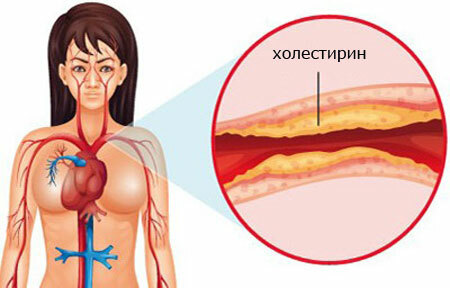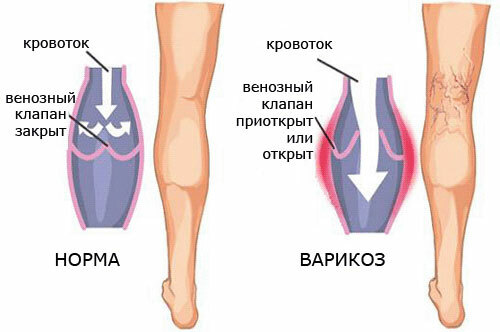What is it? Varicose veins are a disease in which the veins are damaged and thin. The main distinctive feature is the formation of "nodes" in the vessels of the venous link.
Over time, they are filled with blood clots, present a serious danger to humans. In some cases, varicosity can be accompanied by inflammation of the vascular wall.
The main causes are the factors and risks of
The causes of varicose veins are not definitively specified and are not specified by medical science. However, predisposing factors are known to significantly increase the likelihood of this pathology:
- lack of mobility;
- smoking and drinking;
- hyperglycemia;
- atherosclerosis;
- genetic background;
- is overweight.
Among predisposing factors, lack of mobility, especially throughout the day, stands out as a primary cause leading to varicose veins. This factor is most significant for people with sedentary work - drivers, operating theaters, civil servants and computer workers, etc. The list can be continued indefinitely, tk.the proportion of people professionally engaged in sedentary labor has now risen.
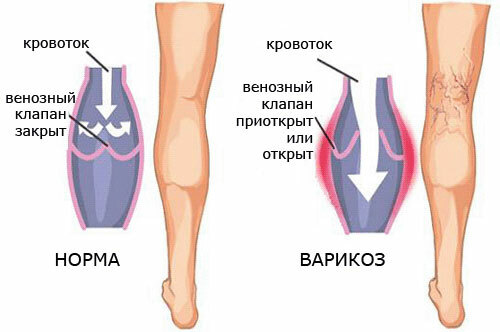
Alcohol and tobacco lead to an increase in the diameter of venous vessels, creating the prerequisites for the development of varicose veins on the legs. The causes of the disease also lie in the genetic background of a person.
This factor, unlike the others, is not modifiable and can not be influenced by patients. According to statistics, many people have a genetic predisposition to varicose veins.
Therefore, they need a particularly careful care of their body, paying close attention to the modifiable factors. Patients with a burdened genetic anamnesis for varicose must definitely give up smoking, alcohol and a sedentary lifestyle.
Excess blood sugar, not metabolized by the liver to glycogen, can additionally damage the veins and arteries. Patients suffering from diabetes mellitus in the risk group for varicose veins.
Cholesterol deposits on the walls of the vessels have a similar effect. It is especially pronounced in deep veins, becausesurface are less prone to atherosclerosis. The latter state is promoted by irrational and unbalanced nutrition, with the dominance of animal fats and the lack of vegetable fiber.
The causes of varicose veins become especially important with excess weight, which increases the load on the heart. It leads to a slowing of the blood circulation, especially pronounced in the lower limbs. In addition, obesity is accompanied by increased intra-abdominal pressure, and this is the background for the development of stagnant processes in venous vessels.
Contents
- 1 Symptoms of varicose veins on the legs
- 1.1 Clinical symptoms of varicose veins, photos
- 2 Treatment of varicose veins
- 2.1 Surgical treatment of varicose veins
- 3 Folk remedies for the treatment of varicose veins
- 4 Which doctor to consult?
- 5 Prevention
Symptoms of varicose veins on the legs
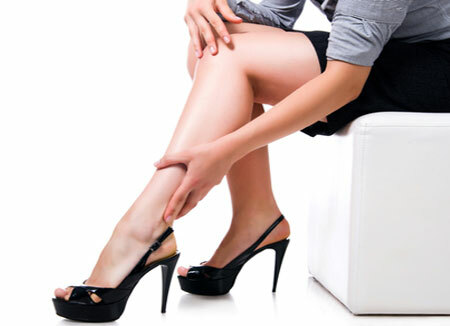
The first signs of varicose veins can be noticed by the end of the day - they are manifested by edema of the legs, which are usually preceded by a period of prolonged standing or walking. As a rule, after a night's sleep, puffiness completely disappears. However, in the advanced stages it acquires a stable character and persists constantly, regardless of the time of day.
The presence of edematic syndrome, localized on the legs and ankles, you can check yourself. For this purpose, a circle at the ankle level is measured twice a day:
- after awakening
- before night sleep.
If the difference is 1 cm or more - this confirms the existing violations of venous outflow and such people need consultation of a phlebologist. In the initial stages of the disease, these symptoms quickly pass after a person for several hours will be in a horizontal position.
The onset of progression of varicose veins is characterized by the appearance of nodes protruding above the surface of the skin. They can be either single or multiple. Most often they are detected from the inner surface of the legs and thighs.
Long standing or walking, as well as prolonged stay in a sitting position, leads to the appearance of new symptoms of varicose veins on the legs:
- feeling of bursting, especially expressed in calves;
- sensation of heaviness in the legs;
- their fast fatigue;
- acute or aching pain, most pronounced in the areas of varicose extensions;
- cramps developing in the calf muscles, especially in the evening and even during sleep.
The appearance of convulsive contractions is associated with a metabolic disorder. The prerequisite for this is the developing venous congestion. Against this background, tissues experience a state of hypoxia, leading to increased convulsive readiness of the muscles.
Therefore, if a person has convulsions, the dopplerography is necessarily indicated. With its help, the state of the venous link in the body is assessed, becauseVaricosity in the initial stages can be asymptomatic.
Clinical symptoms of varicose veins, photo
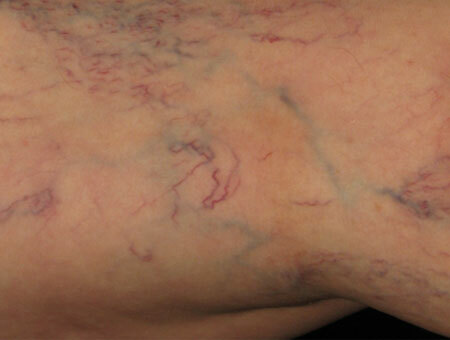
photo 1

photo 2
Clinical symptoms of leg varicose help to presume this diagnosis. Therefore, we will summarize them:
- pain in the legs when walking;
- pain sensations detected by palpation of inflamed veins;
- general aching in the lower limbs;
- evening and night cramps in the muscles;
- sensation of feeling of heaviness and raspiranija in the bottom extremities, especially in the field of ankles;
- visually defined convoluted veins with varicose extensions - they rise above the skin level( this sign is determined only with a superficial form of the disease, with a deep lesion of the veins to identify this symptom is not possible);
- swelling of the legs( with varicose dilatation decreases in a horizontal position, unlike other diseases).
Treatment of varicose veins

Treatment of varicose veins on the legs should be carried out in a comprehensive manner, including non-pharmacological methods and pharmacological correction. When there are indications, surgical intervention is performed. These are the general principles of helping patients with varicose veins.
From non-pharmacological methods , with this disease it is recommended to wear special elastic tights, bandages or stockings. They create the necessary compression, supporting the veins in the tone. The blood flows to the heart more easily, and the venous stasis is eliminated. In such conditions, the vascular wall can not expand to form nodes later.
A significant curative and preventive role is played by physical activities that help prevent the progression of the disease:
- walking at a fast pace;
- gymnastics;
- various activities in the water;
- swimming.
However, not all physical exercises can be recommended for varicose veins. Patients with this diagnosis should be excluded from sports exercises with a heavy load on the legs:
- weightlifting;
- tennis;
- jumping.

The next step in the treatment of is a pharmacological correction. The choice of the drug is done by a doctor. Assignable medicines are divided into several groups:
1. Regulators of the tone of the veins - venotonic drugs. These include:
- Detralex;
- Rutoside;
- Glivenol;
- Troxevasin;
- Endothelon;
- Escuzan.
2. Drugs that help prevent the formation of dangerous thrombi:
- Pentoxifylline;
- Aspirin;
- Anticoagulants, incl.and ointments on their basis( the most famous among them is Heparin and "Lyoton").
Surgical treatment of varicose veins
 In cases of ineffective drug therapy, surgical treatment is indicated. It consists in the removal of pathologically altered veins or in the introduction of solutions that allow to glue the walls of a varicose dilated vessel( sclerotherapy).
In cases of ineffective drug therapy, surgical treatment is indicated. It consists in the removal of pathologically altered veins or in the introduction of solutions that allow to glue the walls of a varicose dilated vessel( sclerotherapy).
Operative treatment of the disease is characterized by high efficiency. However, do not forget about operational risk. For example, in obese people it is higher than that of lean ones. The duration of the operation also plays an important role in determining the operational risk - the shorter the operation, the less likely the thrombus formation. Therefore, it is very important to choose a highly qualified surgeon who removes veins technically and quickly.
Modern phlebology has different methods of operation for varicose veins. The choice in favor of one or the other is determined by the specific clinical case. In this case, the doctor necessarily takes into account the following factors:
- whether there are complications of the disease;
- what are the concomitant diseases;
- what is the degree of operational risk to the patient;
- how likely a relapse, etc.
The most common techniques are:
Phlebectomy is an operation for varicose extension of the legs, involving the removal of pathologically altered veins. This intervention was first performed at the dawn of the 20th century. It is quite effective and is still used, but with some improvements.
Today's surgery performs phlebectomy for various modifications, depending on the author of the change. This surgical intervention can be performed both on large vessels and on surface vessels having a small diameter. To remove the vein, a small incision is made on the skin and an infected vessel is extracted through the probe through it.
Minimally invasive techniques - imply coagulation by electric current or application of freezing with liquid nitrogen. Recently, laser therapy has been widely used. It has fewer side effects, is more effective and technically simple. Its main disadvantage is the high cost.
Folk remedies for the treatment of varicose veins
At home, folk remedies are used to relieve symptoms and treat varicose veins on the legs, they enhance the effect of pharmacological therapy prescribed by a doctor. Such tools can be recommended:
Nettle. The leaves of the plant are dried. After that, boil the water in a volume of 500 ml and pour them. It is better to do this in a thermos. The infusion time is about half an hour. Using a sieve, filter and take a third of the dose three times a day 50 minutes before meals.
Apple cider vinegar. It improves the activity of the coagulation and anticoagulant system, contributes to the normalization of the state of the blood vessels. To achieve a therapeutic effect, they smear the lesions twice a day, and also take inside at the rate of 2 teaspoons of vinegar per glass of water. In day it is necessary to drink from 2 to 3 glasses.
Fresh potatoes is ideal for accelerating the healing of trophic ulcers, formed against the background of a prolonged existence of varicose veins. To do this, it is rubbed on a grater and the resulting gruel is applied to the ulcerative defect by a layer 1 cm thick, covering with a bandage on top.
The exposure should be 4-5 hours. After that, the gruel is changed to a new one or a bandage is moistened in freshly received potato juice.
White acacia flowers - prepare the tincture used externally. It is especially effective in thrombophlebitis( inflammation of the thrombosed vein).Affected places are abundantly lubricated and ground.
Hops cones. Approximate calculation - 1 tablespoon of crushed raw material and 200 ml of boiling water. Within 15 minutes it should be heated on a steam bath.
Take three times a day before a meal for 1 sterile. Local therapy is also performed - in places where the veins are most affected, a compress is made( gauze soaked in cooked infusions).
Leaves of Kalanchoe - prepare tincture. To do this, take a half-liter bottle, fill it with chopped leaves to half, pour to the upper limit of vodka or 40% alcohol. Insist a week indoors without direct sun rays, periodically shaking. Then filter.
Rub the feet before bedtime, especially carefully at the lesions. It is better to do this by massaging movements in the direction from the bottom to the top, i.e.in the direction of venous outflow. The duration of treatment with this remedy is 4 months( after a load of pain in the legs should noticeably decrease).
White cabbage. Remove one sheet and roll it with a rolling pin. On the one hand, which will be applied to the affected area, grease it with vegetable oil. Using a bandage, fix it for a day. This is an excellent tool for thrombophlebitis. The course of therapy is 1 month.
Purity. Tincture from a plant to use three times a day for 10 drops, diluted in 1 tablespoon of milk. Take before meals.
To which doctor should I apply?
Not all people know what kind of doctor to turn to when identifying signs of varicose veins. Previously, the treatment of this pathology involved therapists, and when complications arise, surgeons. However, the development of medicine contributed to the allocation of a special specialty - phlebology, which "budged away" from angiology( vascular science).
Doctors-phlebologists purposefully study only veins, not all vessels. But this does not mean that, if necessary, they will not be able to establish the correct diagnosis, excluding other diseases. They are specialists with a wide outlook, but they are precisely involved in the veins.
Prevention of
Varicose prophylaxis is aimed at eliminating modifiable risk factors. Therefore it is recommended:
- to increase physical activity;
- to stop smoking and drinking alcohol-containing beverages;
- to reduce weight when its excess;
- normalize food by eliminating atherogenic products;
- reduce the amount of sweet foods in the diet.

